Top 33 ecommerce statistics that we think you should know about for 2024.
When choosing to sell online it's vital to under your market, the size of the audience that you are looking to reach, the industry average performance rates and the technology platforms that are best for you. This will allow you to make key business decisions on budget, strategy and growth for your business. Ecommerce is not right for every business and should be carefully considered when choosing if it is right for you. This guide dives into our top 33 ecommerce statistics of 2024!
In the mid-90s, the internet began to see major technological advancements for commercial use - what would become known as 'ecommerce'. Key players such as Amazon became the first businesses to form from selling online and following this we saw marketplaces such as eBay that allowed other businesses to sell products online too. In 2006, The Payment Card Industry Security Standards Council was formed by American Express, Discover Financial Services, JCB International, MasterCard and Visa Inc. to manage the security of payments and selling items online - not just the United States. Since, we've seen the emergence of ecommerce platforms including
Shopify,
Magento,
Woocommerce, Wordpress,
Salesforce develop to allow businesses to sell online without building their technology from the ground up.
This article includes our round of e-commerce statistics that we think you should know about, including facts and figures about ecommerce industry business growth, platforms, global and the experience and results brands see selling online. So without further ado, let us dive into Shopify Statistics and stats that we have hand-picked as being the most interesting for you to consider when selling with ecommerce as a key channel for your business. Ecommerce businesses should pay attention to make sure you are right on trend. This guide will give you the reasons on why you should or shouldn't invest into ecommerce, get more visitors, consider marketing campaigns, maximise customer experience, consider conversions, customer service, onsite factors, cart abandonment rate, shopping cart abandonment, purhcasing decisions customer behavior and merchants leading the industry.
What's included in our ecommerce statistics guide?
Top Statistics For Ecommerce
UK Ecommerce Statistics
Global Ecommerce Statistics
Ecommerce Statistics By Country
Leading Player Statistics For Ecommerce.
Mobile Device Ecommerce Statistics
Traffic and conversion ecommerce statistics
Ecommerce Shoping Behaviour Statistics
Statistics For Ecommerce Platforms
Future Of Ecommerce Statistics
Top Statistics for Ecommerce
1. There are estimated 24 million ecommerce stores across the globe.
Founded in Canada, Shopify revenue for the twelve months ending September 30, 2022 was $5.245B, a 24.59% increase year-over-year. Shopify annual revenue for 2021 was $4.612B, a 57.43% increase from 2020 which shows continued growth across the world-leading ecommerce platform. The platform has shown growing success since it's launch and continues to receive year-on-year revenue growth.
(Forbes) - Top Ecommerce Statistics

2. In 2023, an estimated 2.64 billion consumers will have completed at least one purchase online.
More and more customers are purchasing online every year, meaning the audience to reach is continually growing for ecommerce brands to target. The improvements in security, technology availability, improvements in online experiences and faster internet connections is likely to be the reason for this.
(Insider Intelligence) - Top Ecommerce Statistics
3. Online marketplace originating sales including Amazon and eBay are likely to reach $2.1 trillion by 2024.
Online marketplaces are growing fast, allowing businesses to reach monumental numbers of customers that the marketplaces have already built that otherwise they would struggle to show their products to. Marketplaces not only provide consumer trust and access to wide range of goods they are also great for businesses to expand their product reach.
(Research & Markets) - Top Ecommerce Statistics
UK Statistics for Ecommerce
4. The UK's ecommerce market is the third biggest ecommerce market in the world.
The UK has the third largest eCommerce market in the world after China, and the U.S. Consumer eCommerce now accounts for 36.3% of the total retail market in the UK (as of Jan 2021), with eCommerce revenue projected to increase to $285.60 billion dollars by 2025.
(International Trade Administration) - UK Ecommerce Statistics
5. The UK is expected to have nearly 60 million e-commerce users in 2023.
This statistic presents the number of e-commerce users in the United Kingdom in 2017, and provides a forecast until 2025. According to the Digital Market Outlook, the number of e-commerce users in the United Kingdom is expected to grow to 62,1 million in 2025. Only a very small minority of the UK population are not using ecommerce to purchase goods.
(Statista) - UK Ecommerce Statistics
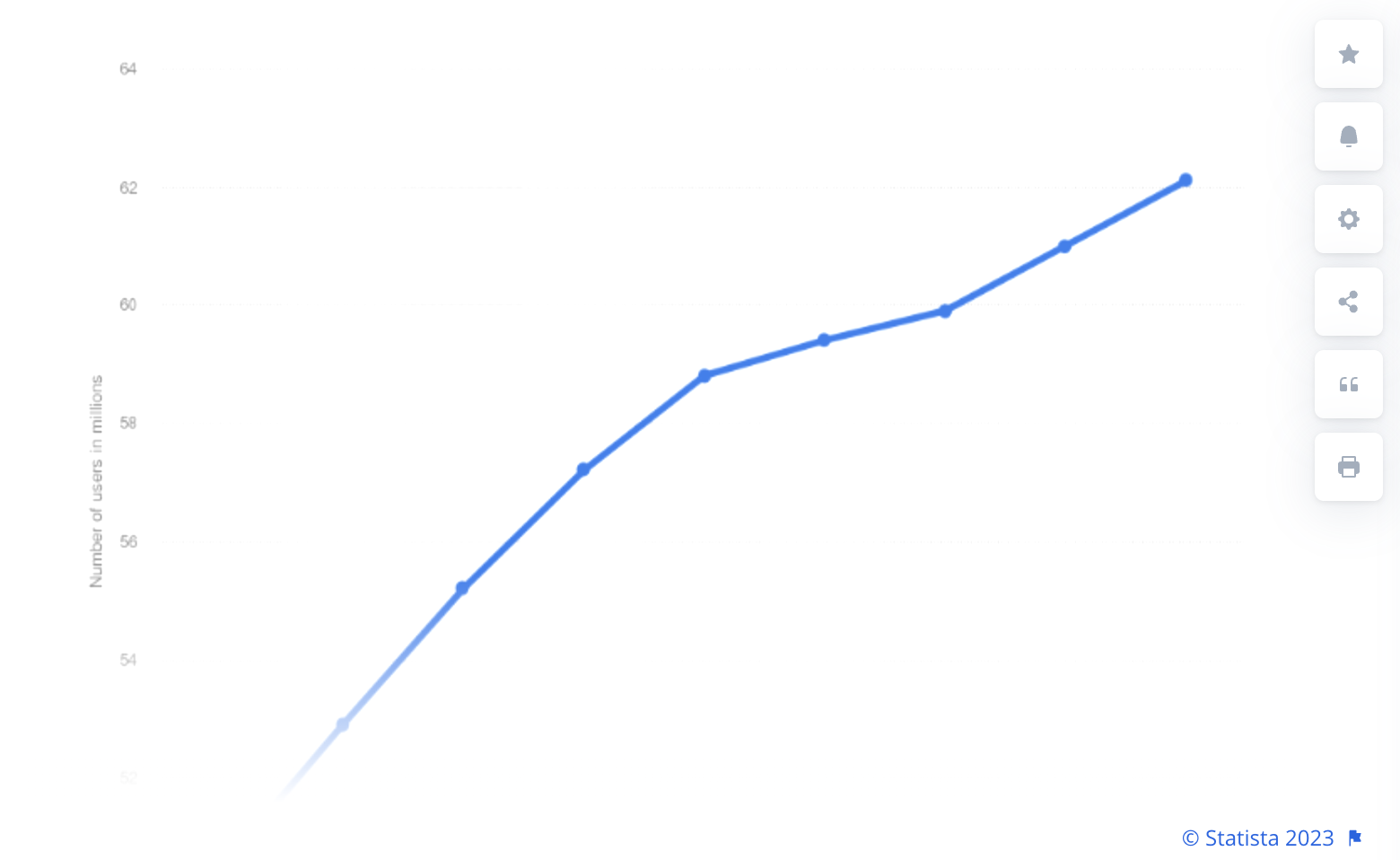
6. The United Kingdom led the country comparison in each year of retail sales spent online.
This statistic provides information on the online share of retail trade in selected European countries from 2014 to 2022. In 2022, approximately 26.5 percent of retail sales in the United Kingdom were generated online. The United Kingdom led the country comparison in each year.
(Statista) - UK Ecommerce Stats
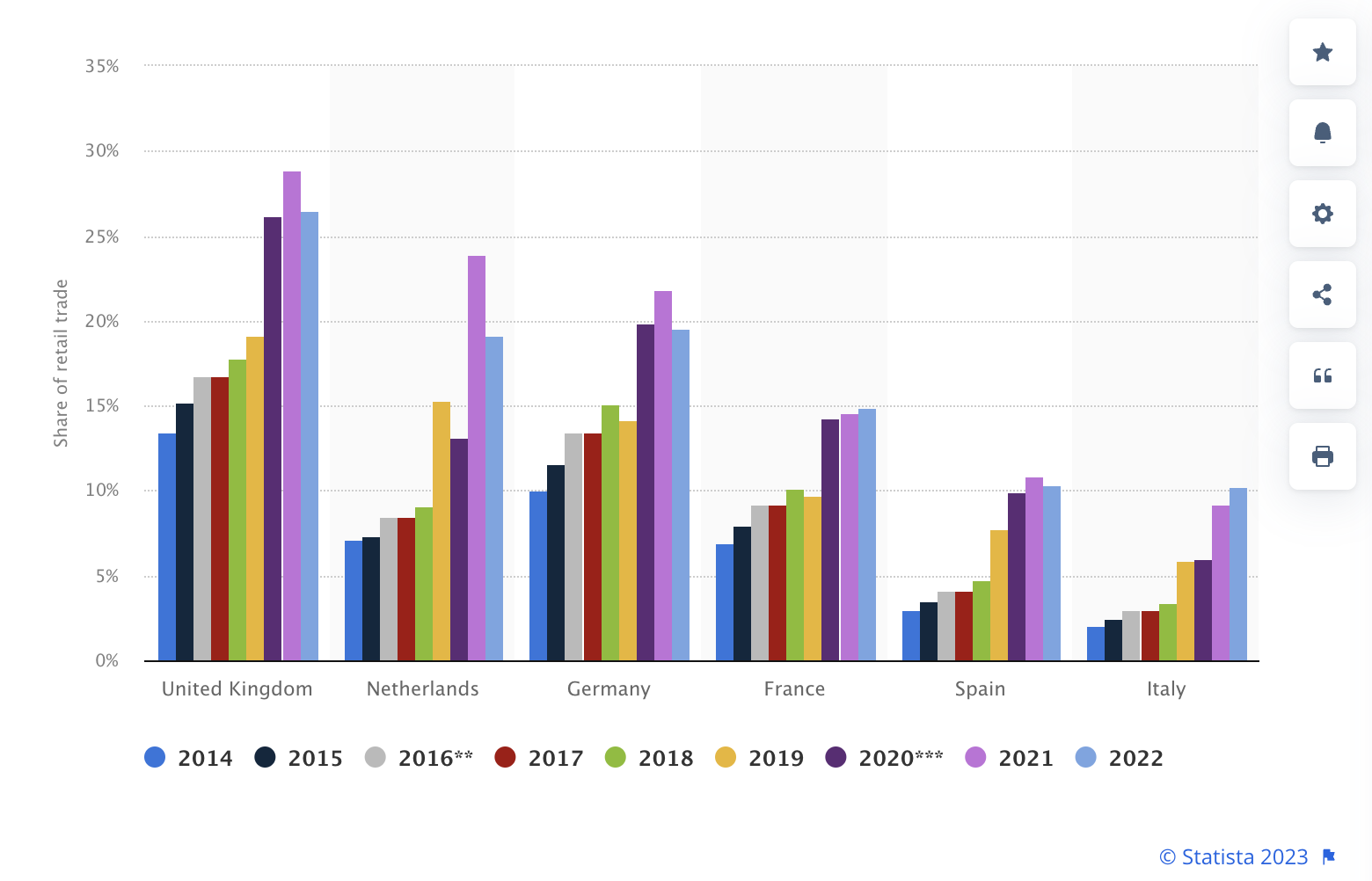
7. June 2023, the value of internet retail sales in Great Britain reached a value of over 2.22 billion British pounds, down from the previous month.
Overall the value of internet retail sales has steadily increased with peaks during the winter season, reflecting sales increase from the holiday season. E-commerce retail sales have been increasing steadily in conjunction with mobile commerce retail sales which are projected to increase to approximately 105 billion British pounds by 2024.
(Statista) - UK Ecommerce Stats
8. Fashion leads on the largest market for ecommerce in the United Kingdom.
Fashion is the largest market and accounts for 28.7% of the UK eCommerce revenue. It is followed by Electronics with 16.8%, Hobby & Leisure with 15.9%, Grocery with 12.3%, Furniture & Homeware with 9.6%, Care Products with 9.4%, and DIY with the remaining 7.4%.
(EcommerceDB) - United Kingdom Ecommerce Stats
9. Retail Sales from ecommerce dropped from YoY September 2023 in the UK.
In September 2022 ecommerce accounted for 26.7% of total retail sales in the UK compared to a lower 25.3% in 2023. This drop is likely due to be more consumers returning to the highstreet following COVID 19 and also a reduction in disposable income.
(Office for National Statistics) - UK Ecommerce Statistics
Global Statistics for Ecommerce
10. The global ecommerce market is expected to total $8.1 trillion in 2023.
Global ecommerce sales is expected to increase to $8.1 trillion in 2023 up from $5.7 in 2022. Sales via ecommerce channels is expected to continually grow online over the next decade however growth is estimated to increase at a slower rate.
(Manaferra) - E-Commerce Statistics To Know In 2024
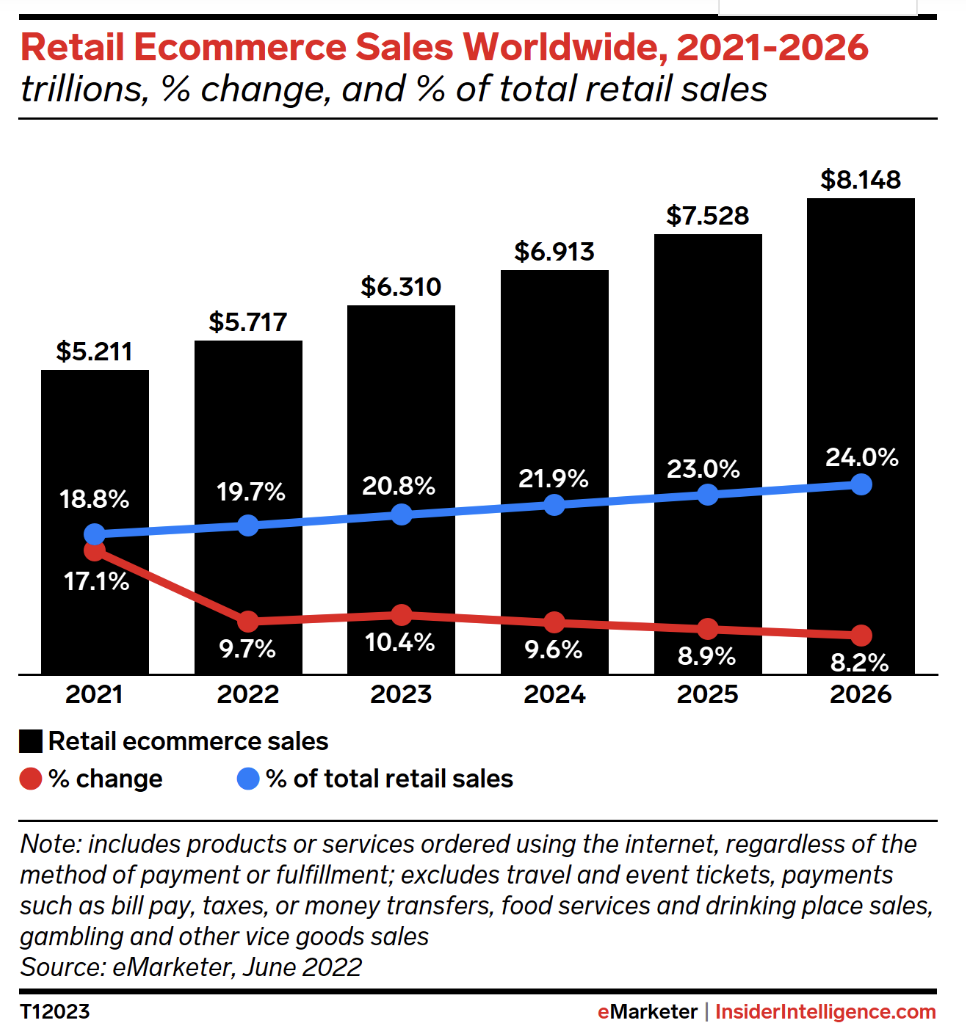
11. Global ecommerce sales growth is set to outpace that of retail sales until 2027.
In 2023, total retail sales worldwide is expected to rise to $29.7 trillion, marking an increase of 5.5% from 2022. This is 3.4 percentage points lower than the global ecommerce sales growth rate.
(Oberlo) - Global Ecommerce Stats

Ecommerce Statistics By Country
12. China leads on ecommerce growth in 2023.
China is set to retain its dominant position in the global e-Commerce landscape. Bolstered by a remarkable growth, the Chinese e-Commerce market is anticipated to surge in 2023, driven by the ongoing shift of consumer preferences from offline to online shopping. China's ecommerce growth is far ahead of all other countries.
(Global Data) - Ecommerce Statistics By Country
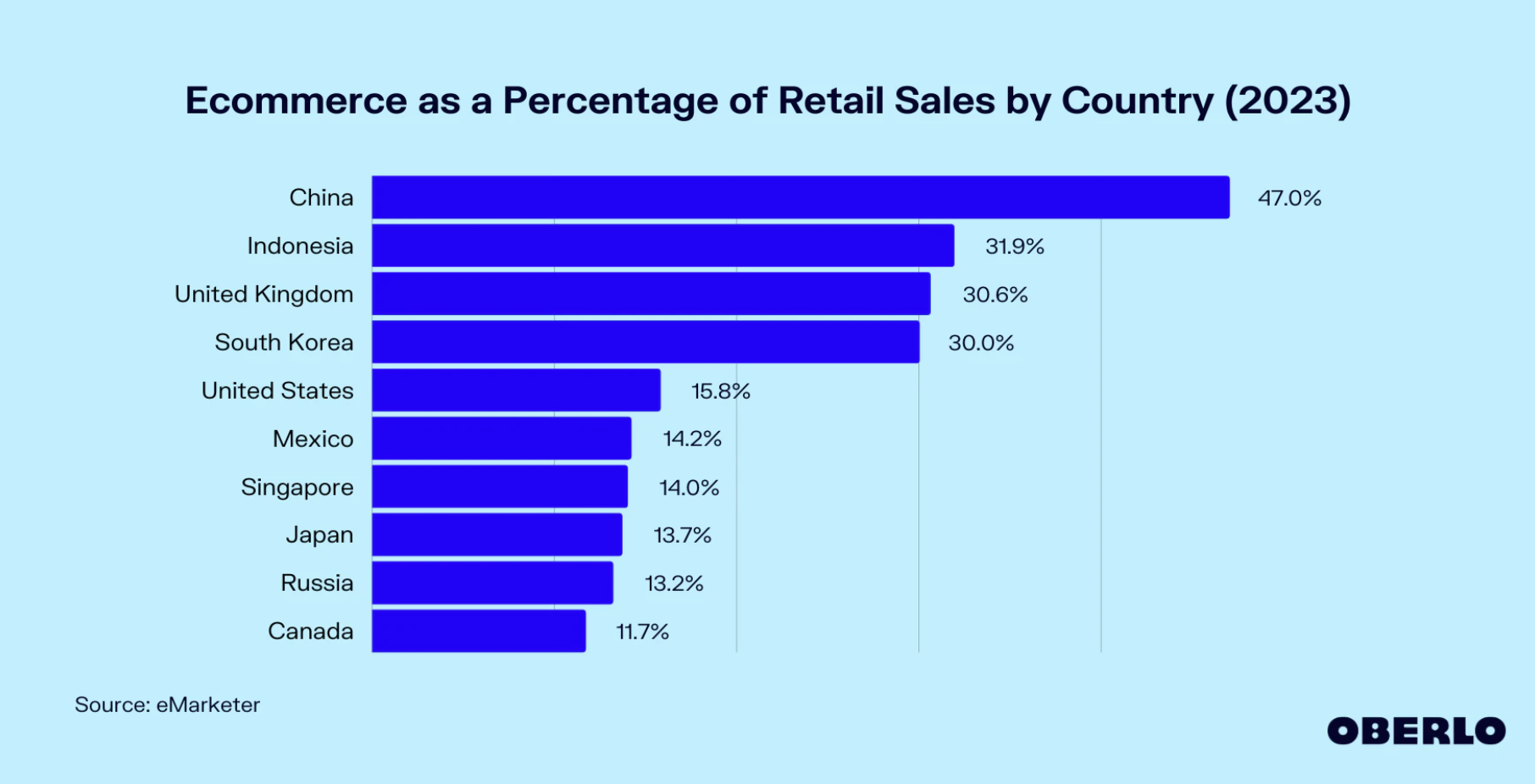
13. US consumers spend $1.1 billion in 2023.
A recent ranking of the ecommerce market size by country shows that China is set to continue reigning as the world’s largest ecommerce market in 2023. According to analysts’ calculations, the country is expected to generate over $3 trillion in ecommerce sales this year—the only country to exceed the $2 trillion mark and by a significant margin.
(eMarketer) - Ecommerce Statistics
14. UK ecommerce sales predicted at $196 billion in 2023.
After China and the US, next on the ranking of ecommerce market size by country is the United Kingdom. Total ecommerce revenue there is predicted at $196 billion. This is followed by Japan and South Korea, which round out the top five with $193.4 billion and $147.4 billion, respectively.
(Oberlo) - Ecommerce Statistics
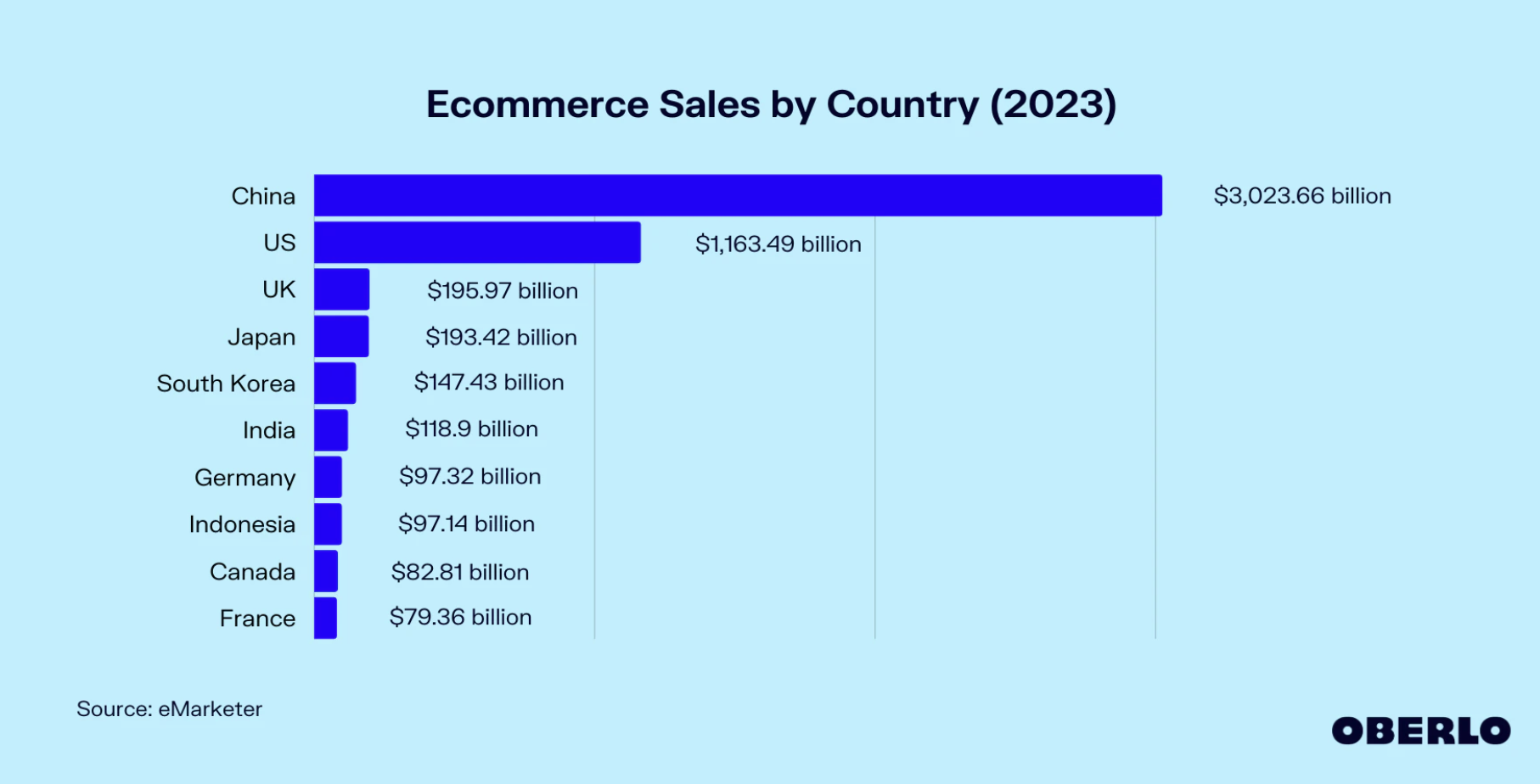
15. China is home to four of the top ecommerce companies in the world.
The top 10 ecommerce companies in the world is currently dominated by US and Chinese firms, with eight of the 10 headquartered in either of these two countries. This should come as no surprise, given that China and the US are the biggest ecommerce markets in the world. Four of the top ecommerce companies are in china alone.
(Oberlo) - Ecommerce Statistics
Leading Players of Ecommerce Statistics
16. Amazon is the largest ecommerce business in the world.
Amazon.com is one of the most prominent e-commerce companies in the world, offering a vast range of products and services, including online retail, computing services, consumer electronics, digital content, and local services such as daily deals and groceries. Amazon's market value is $867.58 billion.
(Doofinder) - Ecommerce Statistics
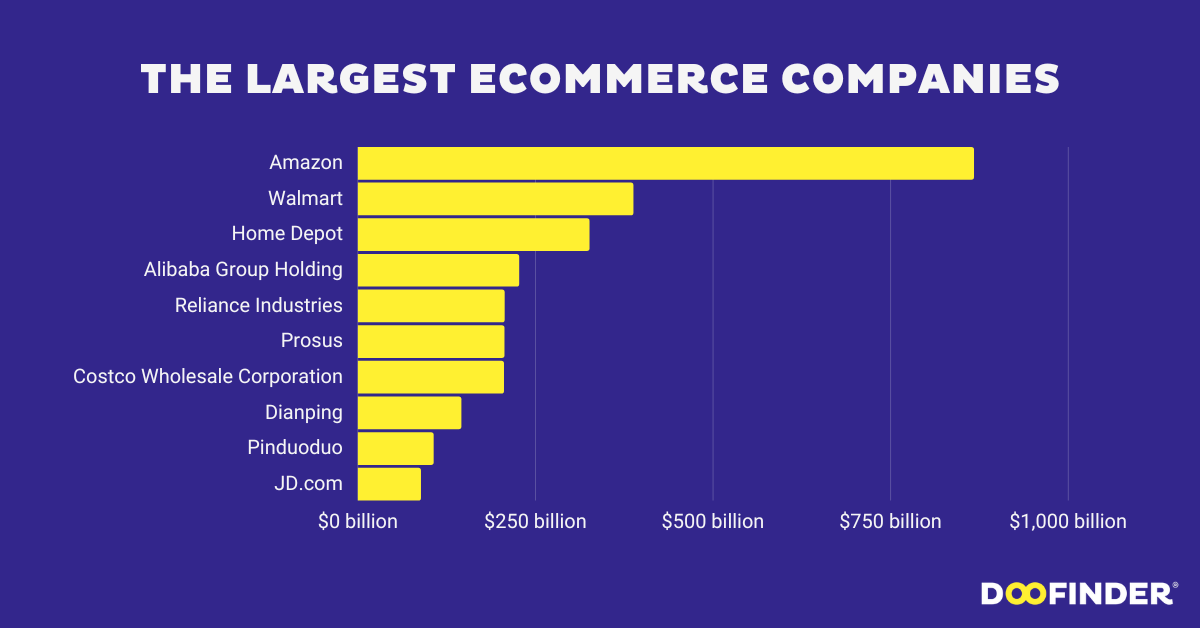
17. Walmart is the second largest ecommerce business in the world.
In 2022, Walmart reached global net sales of almost $568 billion, making it the largest retailer in the world by revenue. The company's gross profit margin remains stable at around 24-25% over the last few years. Walmart's market value is a close second at $387.72 billion.
(Doofinder) - Ecommerce Statistics
18. Home Depot is the third largest ecommerce business in the world.
The Home Depot, Inc., often simply referred to as Home Depot, is an American multinational home improvement retail corporation that sells tools, construction products, appliances, and services, including fuel and transportation rentals. According to Home Depot's latest financial reports the company's current revenue (TTM) is $154.87 B. In 2022 the company made a revenue of $157.29 B an increase over the years 2021 revenue that were of $147.69 B. The revenue is the total amount of income that a company generates by the sale of goods or services.
(Companies Market Cap) - Ecommerce Statistics
19. Alibaba is the fourth largest ecommerce business in the world.
Founded in 1999 as a B2B wholesaler, Alibaba Group is the undisputed king of e-commerce in China. Its business spans across multiple categories, including B2B, B2C, and C2C e-commerce, cloud computing, local service, logistics, and financial services. As of November 2023 Alibaba has a market cap of $210.74 Billion. This makes Alibaba the world's 45th most valuable company by market cap.
(Companies Market Cap) - Ecommerce Statistics
Mobile Devices Ecommerce Statistics
20. Mobile Commerce accounts for over 40% of ecommerce sales.
21. The Apple Pay market share of online payments is 6.21%.
While Apple Pay may be dominating the mobile wallets market, it is still a small-time player in the much bigger online payments market. The lion’s share of online payments, or 56.55% of them, are made with PayPal, while Stripe accounts for 20.94% of the online transactions. This places Apple Pay in third place, above Authorize.net, which has a 4.19% share, and Google Pay, which accounts for 3.26% of all online payments.
(Money Transfers) - Ecommerce Statistics
22. 62% of people who own a smartphone have made a purchase using their device in the past six months.
In fact, 62% of people who own a smartphone have made a purchase using their device in the past six months. But mobile users are doing much more than just using these devices to browse online. They are also using phones and tablets to buy.
(Build Fire) - Ecommerce Statistics
23. Mobile commerce sales are expected to account for 6% of all retail sales in 2023
Also known as m-commerce, mobile commerce sales will hit the $415.93 billion mark, accounting for 6% of retail sales, in 2023. Despite this, however, growth is expected to fall to 9.9%. This is the first time it ever dropped below double digits.
(Forbes) - Ecommerce Statistics
Traffic & Conversion Ecommerce Statistics
24. At least 43% of all e-commerce traffic comes from Google's organic search.
According to Reboot, at least 43% of all ecommerce traffic derives from a simple google search leading to customers finding products and brands they are interested in, to then proceed in clicking the results and exploring the site.
(Reboot Online) - Ecommerce Statistics
25. Smartphones accounted for approximately 74 percent of retail site traffic worldwide.
Mobile phones generate most of the digital commerce website visits around the world and also create the largest percentage of orders. As of the first quarter of 2023, smartphones accounted for approximately 74 percent of retail site traffic worldwide and generated 63 percent of online shopping orders.
(Statista) - Statistics
26. Health and beauty sectors average conversion rate is just under 3%.
Online conversion rates of e-commerce sites were the highest in the food and beverage sector, at 3.1 percent in the first quarter of 2023. Sites operating in the health and beauty sector followed, with a conversion rate of just under three percent. For comparison, the average conversion rate of e-commerce sites across all selected sectors stood at two percent.
(Statista) - Ecommerce Conversion Statistics
Shopify Behaviour Ecommerce Statistics
27. Online shoppers spent an average of about 2.3 U.S. dollars per visit across all verticals.
In the first quarter of 2023, online shoppers spent an average of about 2.3 U.S. dollars per visit across all verticals. Luxury apparel is the category in which consumers spent the most money per visit on average, at 2.71 U.S. dollars, followed by home furniture at just over two and a half dollars.
(Statista) - Behavioural Statistics
28. In 2023, market places were the main way shoppers initially search for products.
In 2023, marketplaces were the primary source for starting to search for products online worldwide. According to a survey, roughly three out of ten online shoppers searched for products through this channel. Browsing in-store ranked second, with 18 percent of respondents, followed by search engines and brand websites, each with 14 percent.
(Statista) - Statistics
29. Mobile wallets leading payment method for online transactions.
In 2022, mobile wallets accounted for roughly half of global e-commerce payment transactions, making the digital wallet by far the most popular online payment method worldwide. This share is set to increase to over 54 percent in 2026. Credit cards ranked second with a 20 percent market share in 2021, a figure which is projected to decline in the coming years.
(Statista) - Statistics
Ecommerce Platform Statistics
30. Shopify takes 20% market share of top 1 million sites.
As you can see, WooCommerce Checkout and Shopify own a majority of the share when it comes to ecommerce platforms used by the top 1 million sites. Previously, Magento used to dominate the market. However, currently, it owns almost 7% of the global ecommerce market.
(Cloudways) - Statistics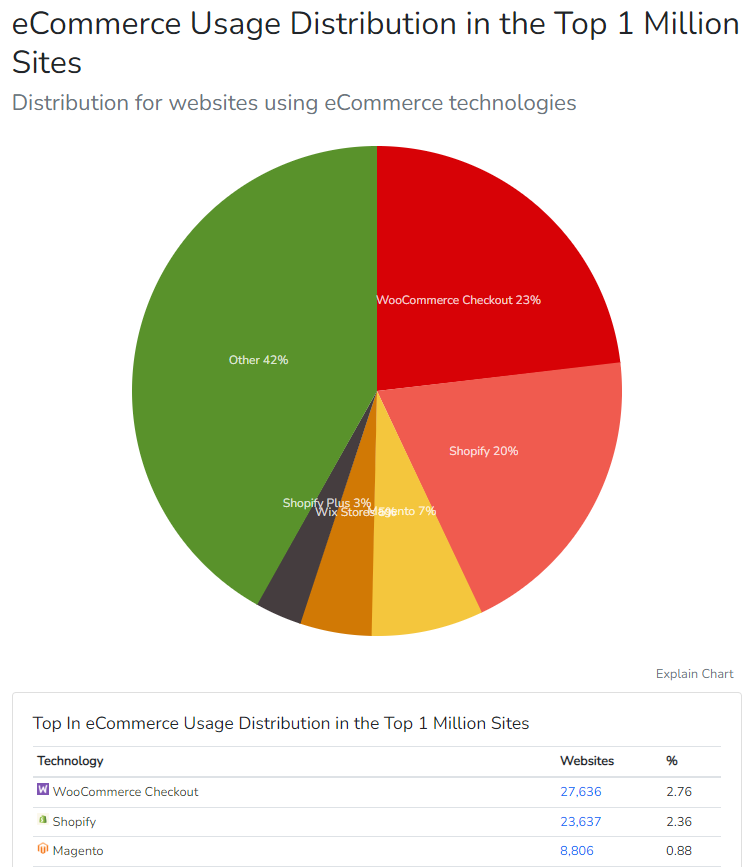
31. Shopify dominates top 10K ecommerce stores globally as platform choice.
Future Of Ecommerce Statistics
32. Ecommerce to continue to grow in coming years.
Over the next four years, it’s predicted that ecommerce growth number will grow by 56%, reaching approximately $8.1 trillion by 2026. Whilst ecommerce sales and performance peaks and troughs, the overal stand is continued ecommerce growth in coming years. Purchases online is a key sales channel fueled by the growth of an improved checkout process, social media, millennials increase usage in technology and retailers investing in online. Shipping, easy carts or online costs and prices are no longer a barrier and trends of shopping online speak for themselves. Buyers are buying a lot from ecommerce sites, industries of all shapes and sizes are investing into advertising, apps, gaining more internet users and improving their shopping experience.
(Statista - Statistics)
33. The number of ecommerce users is expected to hit 3,701.0m by 2028.
In the eCommerce Market, the number of users is expected to amount to 3,701.0m users by 2028. User penetration will be 43.1% in 2023 and is expected to hit 52.5% by 2028. The average revenue per user (ARPU) is expected to amount to US$1.17k.
(Statista) - Statistics
Conclusion























